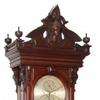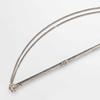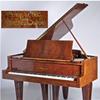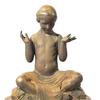Featured 19th Century Painter: Lloyd Mifflin (American 1846 – 1921)
- July 05, 2021 11:15
Lloyd Mifflin has been described as the "artistic squire" of Columbia, Pennsylvania. He received his earliest training from his father who had trained as a portrait painter. From 1869 to 1870, Mifflin began his study under Hudson River School artist, Thomas Moran. During this time he began making sketches in the Susquehanna Valley. This study likely ended when Moran joined his friend, Dr. Ferdinand Hayden, who invited him to accompany him on his 1871 expedition with the U.S. Geological Survey to Yellowstone region. In was in 1871 that Mifflin toured the Susquehanna River from its source in Lake Otsego, Cooperstown, New York to Chesapeake Bay, making sketches of Pennsylvania towns and bridges—Waverly, Towanda, Wyalusing, Tunkhannock, Pittston, Wilkes-Barre-Shickshinny, Catawissa, Danville, Northumberland, Sunbury, Chickies Rock, Columbia, Safe harbor, Peach Bottom and Havre de Grace along the way. He made a stop in Harrisburg to view and sketch its bridges—Rockville Bridge and the famous Camelback Bridge (destroyed by a flood in 1902). The following year Mifflin left for Europe where he studied the great masters in the galleries of London, Paris, Brussels and Antwerp, Dusseldorf, Heidelberg, Bonn, Cologne, Venice, Florence, Rome, Salerno and Cassino. He sketched scenes of the Swiss, French, and Italian Alps. In Germany artist Lloyd Mifflin studied with Herman Herzog and made a trip of the Rhine River, sketching the numerous castles, Mouse Tower, especially catching his eye. It was in Italy where he found the greatest inspiration, however. He was struck by luminosity of the rainbows; how the colors were gradational and merged into each other. Mifflin’s special talent lay in skillful depictions of mountains and bringing light from the center of the picture through clouds and reflected off of streams or objects. He was a master of tonality and luminosity; many of his paintings have an opalescent quality. Upon his return to Norwood, the family home in Columbia in late 1873, he resumed his sketching expeditions, capturing the ageless beauty of Pennsylvania river valleys and the changing face of the towns. Mifflin never fulfilled his early artistic promise. Although his paintings were very good, he did not make a point of sell many during his lifetime. He painted beautiful scenes of the Susquehanna countryside of eastern Pennsylvania. In the 1890s, when he was forced to give up the outdoor art of landscape painting due to ill health, he turned to writing poetry. Mifflin published fourteen books, including 500 sonnets. E. Hershey Sneath of Yale wrote of Mifflin in his 1928 America’s Greatest Sonneteer, "the most prolific writer of sonnets in the history of English and American poetry". After his death in 1921 most of his paintings remained at the family summer home until they were later acquired by the Pennsylvania Historical and Museum Commission. His drawings and manuscripts were acquired by Franklin and Marshall College in Lancaster, Pennsylvania. His paintings were never shown publically until 1996 when they were displayed during a ten-day exhibit in the Columbia Museum of History.
Call now to talk about your interest in this Lloyd Mifflin (American 1846 – 1921) painting: 724-459-0612 - Jerry Hawk, Bedford Fine Art Gallery





















